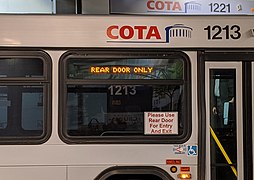Wikipedia:Wikipedia Signpost/2020-05-31/Community view
Transit routes and mapping during stay-at-home order downtime
Amid the coronavirus pandemic, I've been looking for ways to occupy once-precious time. I'm living in Columbus, Ohio, a city largely unknown even to Americans. My latest project is improving content on the transit system here: the Central Ohio Transit Authority (COTA). I'll take you through how I figured out how to list its bus services, and obtain interactive maps of each of the routes.
The agency is peculiar: it's a very advanced network, and it keeps supporting rail transport, though the car-oriented public and state government largely disagree. Columbus is now the largest city in America without any form of rail transit, yet its bus system is extensive, modern, well-organized, and reliable. Perhaps it's because it's single-mindedly focused on bus transit, or because its system is manageably small relative to top U.S. cities, it has one of the highest riderships and most extensive networks for a standalone bus service.[N 1]
I decided a list of routes was important, it's something all similarly-sized transit agencies have. I didn't scan over that many similar articles, but stumbled across good color coding and formats in List of bus routes in Lahore. I decided to adopt parts, using colors to distinguish between COTA's standard, frequent, and express lines. I like how Lahore's list includes compass directions, something I later found most route lists lack. I developed COTA's list to replicate the agency's own standards; for instance, route 10 is titled 'E Broad/W Broad', with front and side rollsigns displaying 'eastbound' or 'westbound', cycling to its destination, either 'Westwoods Park & Ride' or 'Limited Brands'. The 'frequent' route operates every 15 minutes, every day of the week.
-
"102 via N High"
-
"102 to downtown"
I also love maps; I'm a visual learner, and taking COTA, I want to know where it can take me. Google Maps is great at showing rail lines, but never shows bus lines unless you're on its mobile app clicking on individual stops. Even then, it shows every line serving that stop, with nothing to clearly distinguish between individual routes. I was glad to find OpenStreetMap (OSM) has all the routes already in its system, but I had no idea how to make that into maps. I was already very familiar with using {{maplink}} to show interactive maps of where buildings are, but needed to know how to make route maps, and use OSM data in making them.
So after much trial and error, and vainly searching for a tutorial to follow, I managed to make it work. There's a network for OSM editors hosted by Slack, which helped for working out the many kinks for someone who had never dealt with Json or Commons data files before. We developed the method, and then a tutorial: Wikipedia:Creating route maps from OpenStreetMap data. Thanks Minh Nguyễn and Richard Welty!
If you're interested in doing similar mapping, consider registering as part of OpenStreetMap. They make it easy – on their website, hit 'sign up', and it even lets you use Wikimedia's OAuth as an authorization tool. Once signed up, it will immediately guide you through a walkthrough of how to navigate and edit OpenStreetMap. Luckily, the basics are mostly intuitive enough, with many functions similar to Google Maps. To many Wikipedians just starting to use OSM and wanting to perform simple tasks, the tutorial may not even be necessary.
So take a look at List of COTA bus routes. I think all bus and train line articles should include these maps. Especially for systems like COTA, where the routes are very stable, having only changed once in its 50-year history. It's also helped me learn enough to utilize City of Columbus data in making maps for parks, neighborhoods, libraries, National Register-listed sites, and more. I recently created the first up-to-date list of mapping tools too, so you can create your own maps on Wikipedia, and can choose any one of many ways to do it.
Notes
- ^ San Antonio's VIA Metropolitan Transit is the only bus-only network in America that I could find with a larger network and ridership, though at least the city has intercity rail service!









Discuss this story
If it wasn't for the urban sprawl, I would ride COTA a bit more often. That is coming from a guy that hasn't rode COTA in almost ten years because it's not very useful outside of I-270. Nova Crystallis (Talk) 02:36, 1 June 2020 (UTC)[reply]
It's interesting, I might give this a shot on GCRTA when I have more time. Cards84664 13:08, 1 June 2020 (UTC)[reply]
I like the article, and also your post. The latter is probably most useful in providing information about creating maps for a wide variety of articles. Maybe you could publish a "how-I-made-a-map" post from time to time. In the past, I have created a lot of articles about tramway networks and trolleybus systems (eg Trams in Milan, Trolleybuses in Dayton), almost always by translating an article originally published in another language Wikipedia. My creations usually include some information about the tram or trolleybus lines. I seldom update any of that information, because I just don't have the time or inclination. I also live in a city that is literally thousands of kilometres away from the nearest tramway network or trolleybus system. However, other editors are welcome to update my creations, and sometimes do. (You're welcome to add some maps to the Trolleybuses in Dayton article, btw. Someone asked for some about five years ago, but none have been added as yet.) Bahnfrend (talk) 08:48, 3 June 2020 (UTC)[reply]